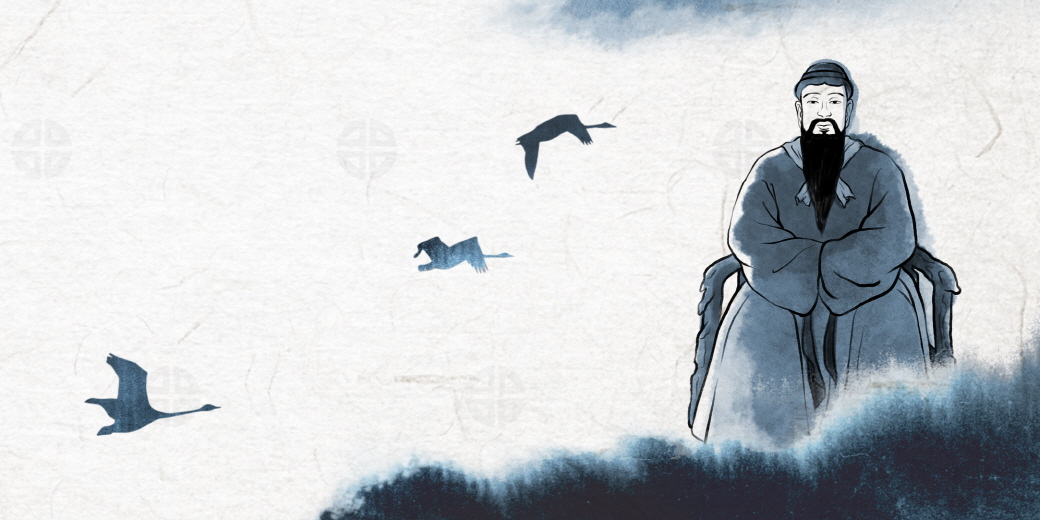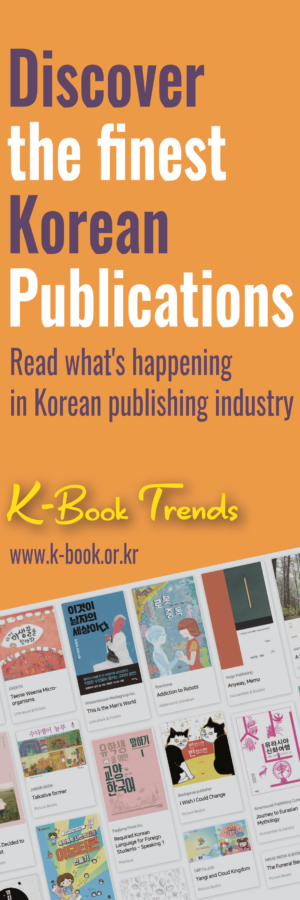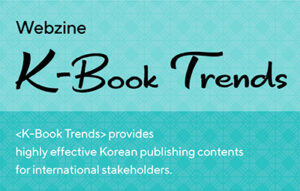Current status of each field in the Korean publishing market
② History Publication
2020.03.02
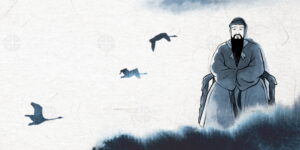 The publication industry is “a mirror called the record” that reflects the society. The publication of history-related books that are the archive of time and space connecting the past and the present is a clear indicator that shows Korean society’s interest in history. By looking at the published titles, best seller trends, and newly emerging trends, you can see where the current publishing market is and where the intellectual desire of readers is heading to.
The publication industry is “a mirror called the record” that reflects the society. The publication of history-related books that are the archive of time and space connecting the past and the present is a clear indicator that shows Korean society’s interest in history. By looking at the published titles, best seller trends, and newly emerging trends, you can see where the current publishing market is and where the intellectual desire of readers is heading to.
Historically, Korea has undergone long turbulent generations due to its geopolitical location in East Asia and invasions by surrounding powers. Until World War II in which liberalization was the greatest task, ethnic identity was very strong, and during the Cold War, a historical awareness that the two Koreas should overcome division and pursue reunification settled down.
According to the statistics of the Korean Publishers Association, the number of new history books published in Korea in 2019 was 2,308, which is up 20 titles from the previous year. Circulation per title was 1,266, which increased by 3.1% per year. Among general books except those for exams and school, history is the only field that saw an increase in circulation. As small quantity batch production spreads rapidly, the rise of the average circulation per the title of history books is unprecedented. The size of the market is not big but is showing an uptrend. The 2019 sales data of Kyobo Bookstore indicates that the number of books in the field of “history/culture” slightly increased, marking approximately 2.5% share in sales.
The publication of history-related books that are the archive of time and space connecting the past and the present is a clear indicator that shows Korean society’s interest in history.
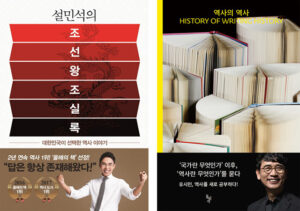
<Annals of the Joseon Dynasty by Seol Min-Seok>, <History of Writing History>
The list of best sellers in the history field last year was mainly led by Seol Min-Seok, a former star instructor. He is famous for easily, clearly, and humorously explaining facts while pinpointing important parts. His <Annals of the Joseon Dynasty by Seol Min-Seok (Segyesa)> has been keeping the first place in the popular books section for a long time; even though the place was taken by <History of Writing History (Dolbegae)> written by author Rhyu Si-Min, former politician, it soon returned to the throne in the history field. This was greatly influenced by a popular TV program that had been making historical visits where the writer Seol Min-Seok participated. In particular, as he became the MC for a reading program on TV (“Book Reading for You”, tvN) in 2019, the books introduced during the program all hit the top ranks of sales including <The Divine Comedy (Starbooks)>, <Hamel’s Journal (Starbooks)>(A 13-year-long record kept by Dutch Hamel who reached Jeju Island, Korea, after a shipwreck. It was the first book that introduced Korea to the world.), <The Little History of the World (Bilyongso)>, a history book of the world written by Ernst H. Gombrich, and <Jingbirok (Hongik Books)> As the year 2019 was the centennial of the March 1st Independence Movement (an independence movement in Korea against Japanese rule) and the diplomatic relationship between Korea and Japan deteriorated due to historical affairs, related books drew great attention as well.

<Annals of the Joseon Dynasty in a Book>, <Annals of the Joseon Dynasty by Park Si-Baek>
The most popular book in the history section last year – <Annals of the Joseon Dynasty by Seol Min-Seok> talks about major incidents related to 27 kings during the Joseon Dynasty (1392-1910) in colloquial sentences as if it was teaching it to a student. The Annals of the Joseon Dynasty, a massive record in 1,893 books, is designated as the UNESCO Memory of the World, being the only chronologically organized record in the world that wrote the history of the kingdom as a diary. In 1996, <Annals of the Joseon Dynasty in a Book (WJ Books Jisik House)> that summarized this record into a book became a mega-hit, and in 2015, <Annals of the Joseon Dynasty by Park Si-Baek(humanist)> that turned the record into a comic book series of 20 books also gained huge popularity.
Explicit content, summarized and organized structure, and fun storytelling were indeed factors behind the huge popularity of <Annals of the Joseon Dynasty by Seol Min-Seok>, but socially, the expanded authority of the Proficiency Test of Korean History also played a significant role as well. Beginning in 2006, this test divided the proficiency level of Korean history into 6 grades; as its usage gradually expanded including extra points for the civil servants’ exam and state-owned enterprises, the number of applicants reached about 520 thousand in 2019.
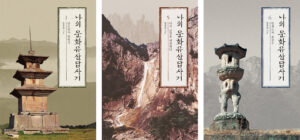
<My Cultural Heritage Discoveries> series
Recently in the history field, due to the bacterial virus COVID-19, <Guns, Germs, and Steel (Literature & Thought)> by Jared Diamond is once again seeing a rise in sales; <The Chrysanthemum and the Sword (Eulyoo Publishing Co.)>, a theory on Japan by Ruth Benedict received a spotlight due to the conflict with the Japanese government on historical issues. Also, <What is History (Kachi Books)> by E. H. Carr is maintaining its position in the rank of high sales in Korea. A steady seller in the field of history and culture that has been on the shelf for the longest is <My Cultural Heritage Discoveries (Changbi)> series by professor Yoo Hong-Joon. Since the first book in the early 1990s, the series that awoke pride for the Korean cultural heritage has headed to China, going through regional field investigations in Korea and Japan.
Meanwhile, microhistory books written by foreign writers are popular as well. For example, <13 Plants Changing World History (Saramnamusai)>, <10 Medicines that Changed the World’s History (Saramnamusai)>, <World History of Tax Evasion (the BOM)>, <The Mosquito (Connecting)> are currently on the list of best sellers.
As small quantity batch production spreads rapidly, the rise of the average circulation per the title of history books is unprecedented.
There are many Korean publishers that published history books. However, there is a surprisingly small number of companies that focus on “history publication” among other various fields. Below are some of the publishers that are putting emphasis on history-related books among currently active publishing companies.
Jisik-Sanup Publications (Established in 1969) : www.jisik.co.kr
Jisik-Sanup Publications has been striving to create <Korean-style World Culture> centering on Korean studies and peripheral studies based on history. Published books are <Korean History and Culture> series, <Introduction to Research on Korean History> and <New Pathfinder for Korean History>, <Anarchism of Korea: Figures>, and <Colony Modernization from the Perspective of a Japanese Scholar> by the Association for Korean Historical Studies. The company has been presenting the “Korean Record Award” to people that have contributed to the records of Korea both home and abroad.
Blue History (Established in 1977) : www.bluehistory.co.kr/xe/pmain2
Blue History is a publisher specializing in history indeed as well as in name. It has been concentrating on publishing history books to create a new history book that matches the level of the public. Popular history books published are <Story of a 500-year-old Prestigious Family> and <Back Alleys of Old Korea>. In regards to the academic collection of scientific journals, the company organized a team for each of the periods from ancient times to Goryeo, Joseon, and the Modern era, and set up project proposals and a team of writers.
Chunga Books (Established in 1979): chungabook.tistory.com
Chunga Books is a publisher established to recommend easy and fun history books to students by the founder that has been running a bookstore near a college. Published books are: <Korean History in a Story>, <Chinese History in a Story>, and <Chronology for Comparison: Korean History and World History>.
Yukbi (Established in 1987): www.yukbi.com
Yukbi began with the publication of a comprehensive quarterly journal <Yeoksa Bipyeong (meaning history criticism)> to build a new historical perception and popularization of studies of history, which then published a book on critical awareness towards the Korean society and history. Published books are: <Korean History>, <Research on Korea’s Modern National Movement>, <Research on the 1894 Peasant Revolution (completed, 5 books)>, <How have we lived in the last 100 years? (completed, 3 books)>, <Exclusive! Korean History in the 20th Century> series, <The Origins of the Korean War 1, 2>, and <Modern China Seen Through Cities>.
Yeoksa Gonggan (Established in 2003): blog.naver.com/jgonggan
Yeoksa Gonggan has been steadily publishing books on Korean history including the “Cultural Area” series that reorganized Korea’s territory from the historical and geographic perspective, <Woosa Cho Dong-Geol Collection (completed, 20 books)>, and <100 Korean Independence Activists> series (50th book published at the moment) which the company is jointly preparing and publishing with an independent planning agency.
Cum Libro (Established in 2003): blog.naver.com/prpub
Cum Libro publishes books of liberal arts centering on history books. The company covers world history and East Asian history that moves away from Western-oriented ideas, foreigner’s travelogues in Joseon, visually-friendly history and culture books, books that talk about the struggles of history educators, and overseas history books. Along with the “Letters from Korean History” series, the first million-seller as a history book for children, almost 100 children’s history books were published. Best books are: <Don’t Know Much About History>, <Korea 1920-1940 by a British Painter Elizabeth Keith>, and <History of World Cuisine>.
Written by Baek Won-Keun (President of Books & Society Research Institute)
